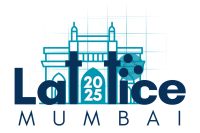Speaker
Description
The Dbar-N two-body system is one of the most fundamental systems involving open-charmed mesons and nucleons. Owing to the absence of quark-antiquark annihilation, the Dbar-N channel is an entirely exotic channel, such that a bound state would correspond to a pentaquark state. While some EFT models predict a strong attraction that could form a pentaquark state, other models suggest only weak attraction or even repulsion, implying no such state [1-5]. Realistic lattice QCD simulations can thus play a crucial role in clarifying the existence (or absence) of a pentaquark state in the Dbar-N channel.
In this talk, we present results for the Dbar-N potential and its s-wave scattering parameters obtained using the HAL QCD method [6,7] . (2+1)-flavor lattice QCD simulations were performed at the physical point with gauge configurations generated by the HAL QCD Collaboration (“HAL-conf-2023” [8]) on a $96^3 \times 96$ lattice with a pion mass $m_\pi \simeq 137$ MeV and lattice spacing $a \simeq 0.0844$ fm. We observe an attractive phase shift in the low-energy region of the I=0 channel and a repulsive phase shift in the I=1 channel. Our results indicate the absence of pentaquark states in both I=0 and I=1 channels.
[1] J. Hoffman, M.F.M. Lutz, Nucl. Phys. A 763 (2005) 90-139
[2] J. Haidenbauer, G. Krein, U.-G. Meissner, A. Sibirtsev, Eur. Phys. J. A33 (2007) 107-117
[3] D. Gamermann, C. Garcia-Recio, J. Nieves, L.L. Salcedo, L. Tolos, Phys. Rev. D 81 (2010) 094016
[4] C. E. Fontoura, G. Krein, V. E. Vizcarra, Phys. Rev. C 87 (2013) 025206
[5] Y. Yamaguchi, S. Yasui, A. Hosaka, Phys. Rev. D 106 (2022) 094001
[6] N. Ishii, S. Aoki, and T. Hatsuda, Phys. Rev. Lett. 99 (2007) 022001
[7] N. Ishii et al. (HAL QCD collaboration), Phys. Lett. B 712 (2012) 437-441
[8] T. Aoyama et. al. (HAL QCD collaboration), Phys. Rev. D 110 (2024) 9 094502
| Parallel Session (for talks only) | Hadronic and nuclear spectrum and interactions |
|---|

